Camping Tents Guide
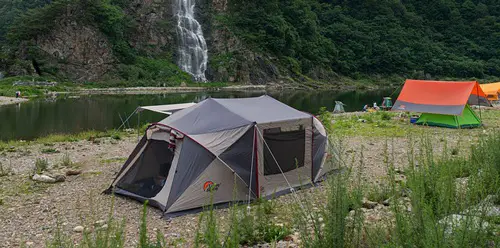
Camping is a favorite pastime for not only the holidays, but any time of the year. Whether it is throwing a line in the water and camping on a river, or setting up the tent at a campsite, camping can be an adventure.
Unfortunately sometimes choosing the correct camping tent can be a bit of a challenge. So in this article we have put together a tent buying guide that will answer your questions about tents. Like the types and designs and the pros and cons of the different tents and styles and questions to ask yourself.
In this guide, we will cover pop-up tents, instant-up tents, swags, family tents, roof top tents, canvas tents and more.
What to think about when choosing a camping tent

There are numerous tent brands, sizes and designs of tents, types like swags, hiking tents, instant tents, prices, assorted quality, function and more. So to narrow down the selection, here are some questions to ask yourself when choosing a tent.
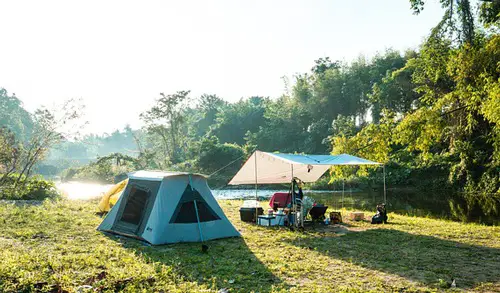
How often will the camping tent be used?
Are you a dedicated camper that goes away most weekends, fishing or exploring the wilderness in remote places and you pitch the tent? Or is the tent just going to be used once a year to set up at the relations house in their back yard at Christmas time?
If you are camping regularly, then the tent should be good quality. You don’t have to spend a fortune, but it is going to get some wear and tear, so a brand name should do the trick.
Setting up the tent and packing up all the time can get old, so if you do camp every waking moment, then the style, such as an instant-up tent might be worth looking at. This saves a lot of time, especially if you value your fishing time. Or camping with the children, you spend less time setting up the tent (less cursing as well) and more time exploring the wilderness.
On the other hand, if you are only camping occasionally, then a budget tent might do. (Be careful in bad weather, like a lot of rain and wind.) For good weather and friendly warm locations, a generic brand tent should work. (Set it up first in your backyard. So you know how it works and if all the poles are there and the zipper work, etc.) As you might only use the tent a few times a cheaper traditional pitch tent might work.
How many people will sleep in the tent?
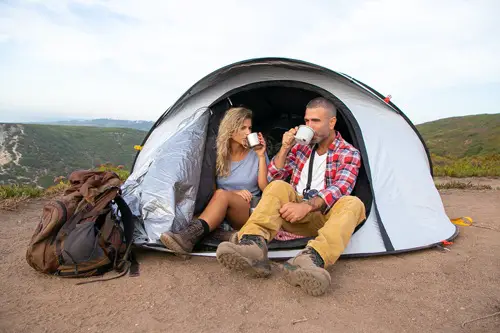
This question one can be a tricky one. Despite the tent manufactures stating the tent will sleep this many, most numbers don’t include that people don’t really want to be squashed in a tent like sardines. Also campers want to include some clothes bags for each person, pillows and sleeping pads in the tent. This means the six man tent listed, is just enough room for three people.
Different tent brands have different standards. But a rough rule is you take the tent manufactures sleeping number and cut in half. So a 10 man tent, may sleep 5 people with some gear.
It is good if you can see the tent at the camping shop like REI or Cabelas all set up on display.
Get your be-loved partner and kids to lay down in the tent and see if you have enough room. (Sure it will be embarrassing as the kids end up wrestling each other in the tent and fighting in the shop, about who is going to sleep where.) But it is better than buying the tent and you realize a 4 person tent, really only fits 2 people and a small bit of gear.
If you use camping stretchers, like the ones that are off the ground, they will take up a lot more room as well. Some inflatable Lillo mattresses, (The ones that get a puncture and you wake up in the morning on the tent floor.) will also take up a lot of real estate in the tent, so just be mindful about what type sleeping gear, mattresses and sleeping pads you use.
Unfortunately with the larger tents that can sleep more, weight and bulk also increases. Have you got a trailer to put the tent in, or is it going to be crammed in the back of the car?
Camping in hot weather in a small cramped tent is no fun. So really thinking about how many people will be mainly sleeping in the tent and extra gear is worth considering.
For the bigger tents, they might have separate rooms, which is great for privacy from the children. Some good tents will have zipper on the room divider walls, so you can open the tent to one big area. Or zip them up for some separate rooms. This is handy for getting changed as well.
Are you backpacking with the tent?
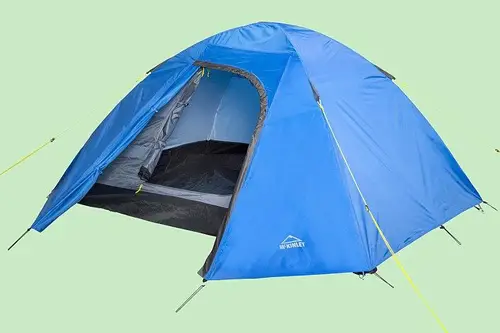
Do you need to carry the tent for a long distance?
Are you backpacking not far from the vehicle, or ultra-light hiking for miles and miles? Or are you pulling up at the campsite and grabbing the tent out the trunk of the car and that is how far you have to carry it.
So the tent weight is very important for the hikers, but not so much for car camping.
Obviously the larger family tents are going to be heavy. Tent materials, like canvas and steel poles are going to be heavier than a new space age lightweight tent material and poles.
Another thing to consider if you use pack racks on the vehicles roof, some larger tents can get very heavy, so check the car for the load capacity on the roof.
If you are adventurous with your camping and you are mountain biking the tent in, or canoeing with all your camping gear, the weight of the tent is also a consideration.
Where will you be setting up the tent?
Are you going to be camping in the winter at the Rockies? Or are you going to warm Texas camping spot in summer?
Where you are camping is going to be another factor to consider what type of tent. A wet and windy place will require a solid tent brand. A good canvas or polyester material from the better tent brands will handle bad weather better.
Some tents have a fly.
With a two piece tent with a fly goes over the main tent mesh and base and the fly protects the tent from rain. The mesh on the main tent allows it to breathe and have airflow, while the fly over it protects the tent from the elements.
A canvas tent will probably be one piece. For windy areas, a heavy canvas helps minimize the wind rattling the tent.
A low quality budget tent can get ripped up by the wind and will have more condensation issues inside the tent. A cheap one piece tent can collect a lot of moisture as it won’t vent well in hot weather or cold damp weather.
Also the lower quality materials can leak through. The construction process, like the seams, stitching and poor design can also mean the tent will gather water and leak in wet weather.
How easy is the tent to put up?
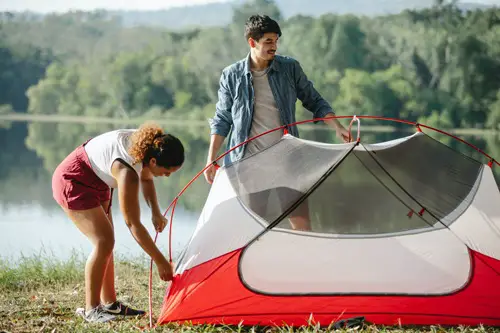
Sometimes at REI and other camping stores they have a TV screen with a video recording on how they sent up a specific tent. The tent manufactures, like Coleman pitch the tent and you can see what is involved in setting it up and how easy it should be. A great promotional idea and these videos work particularly well on the pop-up and instant tent styles.
My favorite tents are the quick set up types. These designs can be set up very fast and within minutes or less.
The pop-up tent and instant-up tent are good if you haven’t got a spare pair of hands to help set up the tent. Also the instant tents save a lot of time and are handy if you arrive at the camp site late at night. Or if it is raining, the set up time can save you getting drenched.
One negative of the quality instant tents and pop up tents is some can be pricey. The lower budget designs can have weaknesses in their connections.
Traditional family tents on the other hand can be good value, but take a little more time to set up. If you have an extra pair of hands or take a bit extra time, the family tents are a proven winner.
Quality A frame designs, dome tents, and other family tent styles have a proven track record and are solid. The heavy poles give stability, and hold up well with bad weather.
How much does a tent cost?
We have talked about quality, size, brands and tent style, these all affect how much the tent is going to cost.
Another factor we discussed was how often you were going to use the tent.
If you are only going to use the tent a couple of times a year, then one of the top of the line best tents, designed for the USA harsh conditions, may be not worth the money spent. Your price bracket might be on the lower end.
However if you are camping all the time, then the price bracket might be worth spending at the higher end. These three tents listed below are larger family tents from known tent manufactures and are at the higher price end.
As an example, here is a tent from called the Wanderer Manor Dome Tent 12 Person tent is under $1,000 dollars, depending on the tent camping sales. It has 3 rooms, with two entrances and a high waterproof rating and sleeps 12. Realistically probably is comfortable for sleeping 6 people. It has a Durawrap fiberglass and steel frame for strength. It weighs around: 30kg.
Here is another higher end tent: The Oztent RX-5 Tent with Living Room is priced under $2,000. This tent has a quick setup design for the main tent. Sleeps around 5 or more, living room, aluminum poles and oversized carry bag. (Fantastic, I am sick of tent manufacturers making too small of a carry bag that takes you twenty minutes to just try and fit it in the tent bag. Well done Oztent!)
Another one is the Blackwolf Turbo Twin 300 tent. This one is priced around $1,200 to $1,300 for a large family tent. The Turbo Lite Twin can be configured into one large room, or made into three separate rooms.
Below is some examples of cheaper tents. These ones are the smaller dome tents that sleep a couple of people and are under $100 dollars.
The Wanderer Jak and Jill Dome Tent. This one is a 2 person tent, so ideally sleeps one person and a bit of camping gear. It has flexible fiberglass poles and insect mesh and a vented roof to reduce condensation and heat. This tent will set you back around $50.
Another lower priced tent is the Spinifex Leeman Tent. It sleeps two, so better for one person with some luggage. This tent is valued around the $40 dollars and has a separate fly. Ideally making it better for reducing condensation and allowing airflow. Internal pockets and a large front opening.
As you can see the prices for the tents can range widely from the higher end large family tents, from a grand or two, to the small two people dome tents for around $50 bucks. So taking into account the questions of size, how often are you going to use it, etc., you can work out a budget for the best value tent that would suit your circumstances.
There are plenty of prices in between these lower and higher price brackets, so that you can find some fantastic value tents. Camping sales before Easter, Christmas holidays and Black Friday, etc. are worth checking out.
The free VIP and club memberships from camping stores are worth signing up for as you can also get some good exclusive camping gear sales.
REI, Cabelas and Bass Pro are also checking out for tent sales and camping gear.
A look at the different types of tents for camping.
Now we have talked about some price ranges, tent sizes, sleeping room and how often you might go camping, let’s discuss some individual styles and designs of tents.
What are pop-up tents?
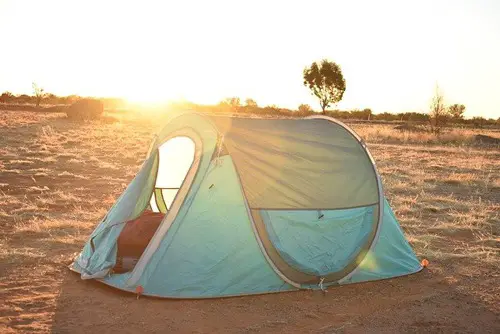
Pop-up style tents are great for quickly setting up.
Most are small dome tents that sleep one, two or three people and go up in a flash. When you get them out of the carry bag, they spring into action and set up. So stand back.
I nearly knocked down one of my kids with a pop-up tent when I took it out of the bag, so be careful.
Once it springs open and sets up, all you have to do is peg them down into the ground.
Now I said they are easy to set up, but packing them up is a different story!
You have to twist them exactly the precise way, or they won’t bend and fold down correctly.
Don’t do what I did and didn’t look at the instructions while trying to pack it up. I gave in at the end and had to follow the instructions to the letter.
Speaking of tent instructions, keep them in your tent carry bag as you do not want to lose them. (The better tent designs will have pictures on the carry bag, or sown in on the tent bag, so you don’t lose them.)
Pop up tents while generally are light in weight, but are too bulky when packed up for hiking of back packing. They look more like Captain Americas shield. They can be nice and flat, but too round to carry any reasonable distance in the bush.
Overall they are great for a weekend camp, but limited in space inside. Easy and fast to set up, but take some patience to fold up. Packing up isn’t ideal if you have a hangover and no patience.
Pop-Up tents are ideal when the kids are starting to grow and the family tent doesn’t have enough room in the main tent. For the price, they provide an extra sleeping space and room for the children to set up near the main tent.
Pop-up sun shade tents are ideal for the beach as well, as they are quick to set up.
This is very handy when you say to the kids, “Don’t go in the water yet. Wait until I set up the sun shade tent, then you can go for a swim.” You then turn around and the kids are already in the water. Luckily the tent sets up in a flash!
Pitch tent designs
The pitch tent is a good compromise for price and has a wide range of sizes. These traditional designed tents can range from a couple of people sleeping size to the larger twelve person roomy tents.
Most of the tents have a separate fly covering which helps waterproof the tent and allows good ventilation and helps with condensation issues during the night.
While not as quick to erect as the instant-up or pop-up tents, they are reasonable easy to put up and are practical in design.
These are probably the most common type of tents in a wide variety of brands, sizes and prices to suit most campers.
The pitch tents have come a long way in design from the ones that had six hundred elbow and pole sections and a big pole in the middle of the tent that took up all the room.
Larger family tents
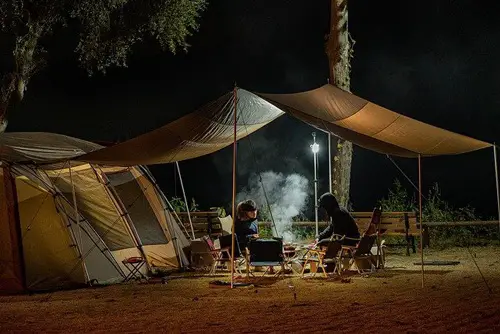
Some of the best tents in the luxurious group are the larger family tents. As they provide a lot of flexibility by zipping up additional panels or walls to divide the tent into separate rooms, or leaving them in one bigger space room.
The front awnings offer shelter to store chairs and other camping gear from the weather. The awnings also offer extra shade for hotter climates.
Most family tents are made from good materials, as with the larger design needs stronger walls, roof and materials. With more foot traffic the bathtub floor is durable in the quality tents.
If you have a large family or plenty of people in the camping group, a family tent is worth checking out.
While they are heavier and take extra time and some man power (or lady power) to set up, the extra room and size is worth it for big groups and longer stays.
Quick tents, fast-pitch and instant tents.
Fast frame or instant set up tents are my favorite tents, as they can be set up within minutes.
These tents are bigger and more durable then the pop-up tents, but quicker to put up then traditional pitch tents.
Most have a joined frame that hinges at the joints and you just hinge out and extend the leg poles out. Throw the fly over top and hammer the pegs in and you are good to go. (Or I should say stay.)
The better quality modern instant tents are nearly as strong as the pitch tents.
For an unplanned overnight stay or for a planned camping holiday, the fast pitch tent is worth considering.
The tents pack down well into a reasonable size and are just as easy to pack up as set-up.
One drawback of the quick tents is they can be more expensive for their sleeping size. In recent years however they are getting less expensive and falling in line with other tent styles for their size and price.
Here are a couple of examples of the fast-pitch tent brands below.
The Coleman Instant Up Darkroom 10 person tent is one you can set up in minutes. It has a special coating on the external rain fly which blocks out the light. This is good for campers or families who want to sleep in on the holidays. The coating also helps regulate the tents temperature and keep it cooler in summer.
The welded floors and seams help keep the weather out. Reflective guy lines are a great idea so people don’t accidentally trip over the ropes and the Coleman Instant Up Darkroom has them for visibility. Check the camping shops for the latest price.
Another tent range is the Oztent RV-4. It is a fast-pitch tent with a pull out floor section. Waterproof and made out of rip stop material, this is a quality tent. With a bit of planning and know how, it can be set up easily in thirty seconds. In comes in around 23 kg and has a heavy duty tent bag. I like the simple and solid design of the Oztent.
The OzTrail Fast Frame 4 Person Tent can be set up in minutes with its easy system. The fly combines into a front awning allowing extra shade. Stated as a four person tent, it should work for two people with some gear, or three campers snuggled inside. Internal hanging points and the fast frame design comes in different sizes as well.
Canvas Tents
The older army style canvas tents have no floor. (The spiders would always get in and love climbing the inside walls.) Gee they were heavy, but also very solid. The poles are thick and sturdy, but they do stand-up well to the strong wind.
The newer canvas tents have a built in bathtub floor, these tents are very solid and more durable than most materials.
For winter camping they trap the heat in nicely, but can be hot in summer without large windows.
You can get years and years of camping from a good canvas tent and if looked after the tent could be passed down to the next generation of campers.
The drawback if the canvas is they are heavy and can be pricey. The good old canvas tent is a symbol of the old tent camping scene.
Swags for camping
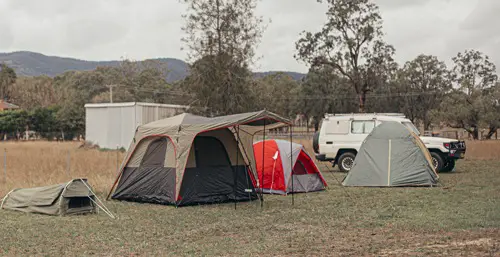
Swags are getting more popular every day in the camping scene. (Above photo: Swag on left compared to tents.)
There are a limited range of brands on the American market and designs.
Double swags, single swags, free standing swags, multiple doors, storm flaps and windows covered with mosquito netting in all places, the selection today is endless.
Kings swags have really cornered the market with some durable designs.
Oztrail swags, Dune swags, Boab swags, Burke & Wills swags and Darche swags are worth doing your homework on quality and finding the best swag price for your hard earned money.
The benefits of a swag is that the mattress and bedding can be rolled up in one. You do seem to sleep very well in a swag.
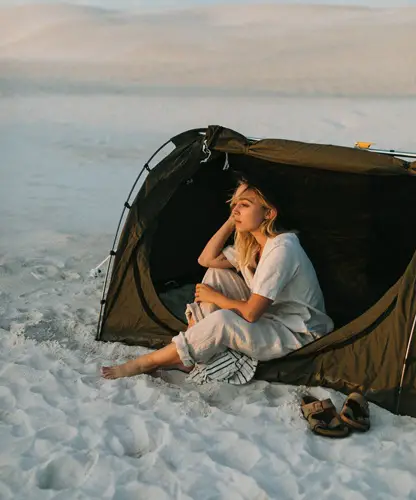
Due to their small internal room, for cold areas a swag can retain a lot of warmth.
Some of the double swags look more like mini tents.
Despite its popularity for camping, the swag has its drawbacks like most camping gear.
Swags are heavy and bulky compared to their small internal room inside.
Swags are not for backpacking as they are too heavy.
Swags can be costly.
Getting in and out of them on a rainy day and you can get wet.
Changing clothes inside a swag is a pain.
On hot days, swags can get very uncomfortable due to the small space inside. Even with the storm flaps open. Some designs are obviously better than other for hot weather.
If you understand the swags many limitations, it might be a choice for you. They do look good though when camping though.
Bivvy bags
The bivvy bag is a great tool for the minimal camper or hiker.
They are basically a waterproof cacoon that goes over your sleeping bag and sleeping pad. Some are set up like swags and have a flexible fiberglass hoop pole. Other designs are used so a storm flap is draped over your head area.
Some bivvy (also spelt bivy) bags have an insect mesh in the hood.
Because of their light weight they are great for light weight backpackers, minimal campers and survivalists. They are also popular in military organizations all over the world.
One drawback is they can get expensive for a good quality bivvy bag like with Gore-Tex material in it.
On hot nights they can get hot and sweaty and is a negative for the design.
Also getting in and out of them on rainy days, you can get wet like a swag. However by setting up a lightweight tarp overhead they are a great option for camping light.
I have had mine for over thirty years and wouldn’t swap it for the world. (Well maybe the world, but you get the point.)
Roof top tents
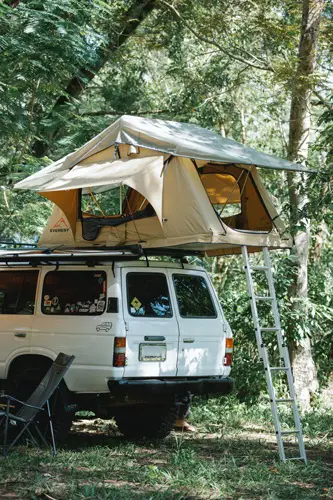
Roof top tents are set on top of the vehicle. They are attached to the roof racks and have an access ladder to get up and down to it.
A roof top tent has the mattress set up in them, much like a swag. One advantage is they free up the internal space in the vehicle, as the bedding is not inside the vehicle.
Some brands are easy to set up and even have an annex underneath half of the top, for additional camping room.
For areas that are wet or limited space, the roof top tent is a great idea.
I reckon these would be good for camping where there are alligators. As you are safely high up away from the ground in alligators and snake areas when camping near the water.
Some cons of the roof top tents are they can be heavy, so check the car for the load capacity rating on the roof. Your vehicle set up has to be able to support the set up and weight of not only the tent, but the people sleeping in it as well.
Another drawback is on windy nights, as you are up higher, it can get some wind.
One thing I am worried about is if I have a few beers and have to get up in the middle of the night to go to the toilet and I forget I am two yards off the ground. (I guess a wee bottle would be a good idea.)
Overall the roof top tent is a great way of saving room and for a fold open tent, you don’t need a trailer to carry it.
Hiking tents
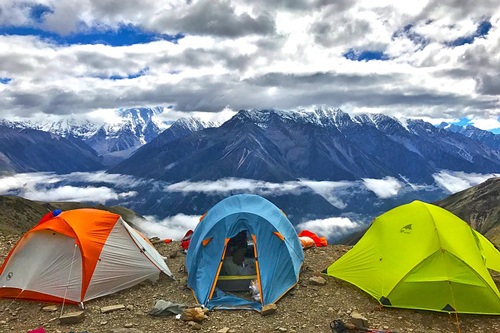
Hiking tents are basically lightweight that sleep one, two or three people. They are compact tents and might be a dome, A-frame or rectangle low profile design.
Hiking tents can be further broken down into roughly three unofficial categories, like:
- Basic hiking tents that are light / medium weight and don’t cost too much. Ideal for the average backpacker.
- Lighter ones from well-known brands and they are starting to get expensive.
- Ultralight hiking tents that are made with new space age material. The material is light as a feather, but very expensive. These tents are used by dedicated hikers. Ultralight hiking tents are also used by specialist, “thru-hikers” who travel long distance trails as fast as they can. Hiking poles are used as the tent poles for some tents to save weight. Every bit of camping gear is weighed and scrutinized in saving a gram or ounce of weight in their hiking gear.
The basic backpacking tents are getting better every year in quality and the prices are good, compared to twenty years ago as the market is more popular and more tent manufacturers are making them.
For the very lightweight hiking tents the materials are very thin and you have to be careful with some materials.
Tents rated for the seasons and weather
While more popular in America than other parts of the world, some manufactures rate their tents with seasons in mind. Such as a two season tent is for good weather.
Here is the category ratings:
Two-season tents.
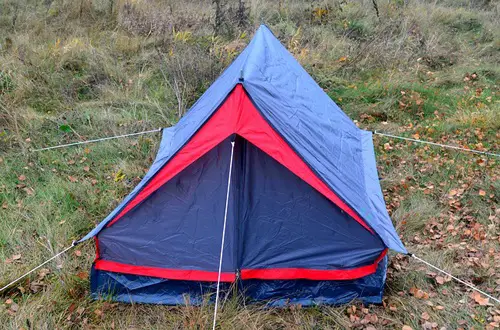
These tents are okay for the occasional use, or the kids sleeping in the backyard. Some are designed with one skin and don’t have a fly. They are more designed for fine good weather or a light shower. Not for a heavy downpour of rain.
They are normally very cheap in price, but the quality control is lacking.
Some of the lower quality tents from Kmart and Walmart tents might be rated as two season tents. Mind you Kmart and some cheap stores occasionally do have some good tents on and off over the years, so check them out for a bargain or camping tent sale. Don’t use them for very wet or cold areas though.
Before you head out into the remote bush in wintertime, set the tent up in the back yard and throw the hose on it. (I don’t mean literally.) Spray with water and see how it holds up inside and if there are any leaks.
Three-season tents
These tent are designed to withstand some worse weather and are generally better quality then the two-season.
A fly is normally used with the design and this provides better breathability against condensation and rain.
Four-season tents
Better quality and designed with all types of weather in mind. Unless you are exploring the Antarctica, these tents will do just fine.
With these tents you are getting quality state of the art materials. The price tag is creeping up with these tents. Some great hiking tents and brands are four seasoned designed tents for most conditions.
Five-season tents
These tent are the most expensive priced, but are designed to battle the weather in bad conditions. High winds and snowstorms, these tents are for the experienced traveler and explorer.
Camping tips for winter. Extra weather protection for camping.
An extra tarp or two is always a good idea when camping as you can set it up for extra water proofing over the tent or entrance.
Or place the tarp it on the inside bathtub floor for leaky tents. (With the corners turned up, not close to the side of the tent so no water will run on it.)
The tarp when set up off the tent, can double up for extra undercover room, such as a kitchen area to prepare the food. Or just somewhere to relax on a rainy day, rather than getting stuck inside the tent all day.
Under the tarp is a great place to store you chairs at night, otherwise the dew can make them damp and wet.
For hot places, the tarp can be easily set up for additional shade as well.
Sometime placing a small tarp under the floor of the tent is a good idea. (Footprint tarp.) As normally when you pack up the tent, even in dry weather, underneath the tent floor can be damp or wet. If you packed up the tent when the flooring is wet and it is stored away, you can get mildew and the tent can rot away. What the tarp underneath does is allow you to pack up the tent properly and store it for a long time knowing it is dry when you put it away.
You just only have to dry and air the tarp, which is a lot easier than airing out the whole tent.
I generally don’t use a tarp underneath, but it can be handy if you have to pack up and leave by a certain time. Such as at a caravan park and be out at ten o’clock in the morning. This way you can roll up the damp tarp to dry later, but the tent is dry!
When setting up the gear inside the tent, be careful you don’t place the bedding against the tent wall or it will soak up the damp tent walls. Be careful placing bags of clothing or items on the tent walls.
For more camping tips, tricks and hacks, visit – Camping Tips. and Safe Camping.
What else do you need camping with your tent?
Camping chairs are a great luxury to have when camping. To sit down and rest the feet around the camp fire is a great treat.
A camp table to place some cooking gear on. Speaking of camp cooking, if you are not going to cook with the campfire, then bring a portable gas stove. Or a cooking stove like the Jet boil is a good way for the backpackers.
As mentioned above in the article, a tarp is very handy for the wet, or for shade near the main tent. For the minimal size of one, put it on the camping checklist.
Remember the bug spray and the marshmallows and you are getting there.
Conclusion – Choosing a tent
Hopefully we have giving you plenty of good information about tents and what to look for when buying a tent.
Also about the many design and types of tents. Like: swags, bivvy bags, hiking tents, roof top tents and other styles, like: pop-up tents, instant tents, family tents, canvas tents and the pros and cons of each type.
Remember to check out the tent sales for some great bargains now that we know what to look for. Thank you for reading the article and see you in the great outdoors.
